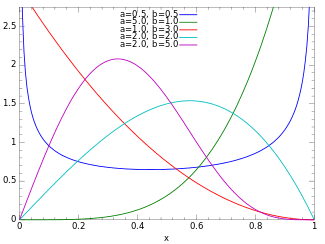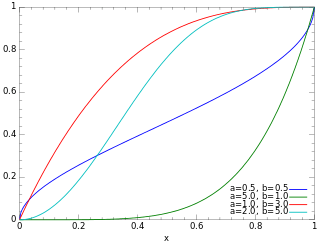Kumaraswamy distribution
|
Probability density function
| |
|
Cumulative distribution function
| |
| Parameters |
(real) (real) |
|---|---|
| Support | |
| CDF | |
| Mean | |
| Median | |
| Mode | for |
| Variance | (complicated-see text) |
| Skewness | (complicated-see text) |
| Ex. kurtosis | (complicated-see text) |
| Entropy | |
In probability and statistics, the Kumaraswamy's double bounded distribution is a family of continuous probability distributions defined on the interval [0,1]. It is similar to the Beta distribution, but much simpler to use especially in simulation studies due to the simple closed form of both its probability density function and cumulative distribution function. This distribution was originally proposed by Poondi Kumaraswamy for variables that are lower and upper bounded.
Characterization
Probability density function
The probability density function of the Kumaraswamy distribution is
and where a and b are non-negative shape parameters.
Cumulative distribution function
The cumulative distribution function is
Generalizing to arbitrary interval support
In its simplest form, the distribution has a support of [0,1]. In a more general form, the normalized variable x is replaced with the unshifted and unscaled variable z where:
Properties
The raw moments of the Kumaraswamy distribution are given by :
where B is the Beta function. The variance, skewness, and excess kurtosis can be calculated from these raw moments. For example, the variance is:
The Shannon entropy (in nats) of the distribution is:
where is the harmonic number function.
Relation to the Beta distribution
The Kumaraswamy distribution is closely related to Beta distribution. Assume that Xa,b is a Kumaraswamy distributed random variable with parameters a and b. Then Xa,b is the a-th root of a suitably defined Beta distributed random variable. More formally, Let Y1,b denote a Beta distributed random variable with parameters and . One has the following relation between Xa,b and Y1,b.
with equality in distribution.
One may introduce generalised Kumaraswamy distributions by considering random variables of the form , with and where denotes a Beta distributed random variable with parameters and . The raw moments of this generalized Kumaraswamy distribution are given by:
Note that we can reobtain the original moments setting , and . However, in general the cumulative distribution function does not have a closed form solution.
Related distributions
- If then
- If (Uniform distribution (continuous)) then
- If (Beta distribution) then
- If (Beta distribution) then
- If then
- If then
- If then
- If then
- If then , the generalized beta distribution of the first kind.
Example
A good example of the use of the Kumaraswamy distribution is the storage volume of a reservoir of capacity zmax whose upper bound is zmax and lower bound is 0 (Fletcher & Ponnambalam, 1996).
References
- Kumaraswamy, P. (1980). "A generalized probability density function for double-bounded random processes". Journal of Hydrology. 46 (1-2): 79–88. doi:10.1016/0022-1694(80)90036-0.
- Fletcher, S.G.; Ponnambalam, K. (1996). "Estimation of reservoir yield and storage distribution using moments analysis". Journal of Hydrology. 182 (1-4): 259–275. doi:10.1016/0022-1694(95)02946-X.
- Jones, M.C. (2009). "Kumaraswamy's distribution: A beta-type distribution with some tractability advantages". Statistical Methodology. 6 (1): 70–81. doi:10.1016/j.stamet.2008.04.001.
- Lemonte, A.J. (2011). "Improved point estimation for the Kumaraswamy distribution". Journal of Statistical Computation and Simulation. 81 (12): 1971–1982. doi:10.1080/00949655.2010.511621.

